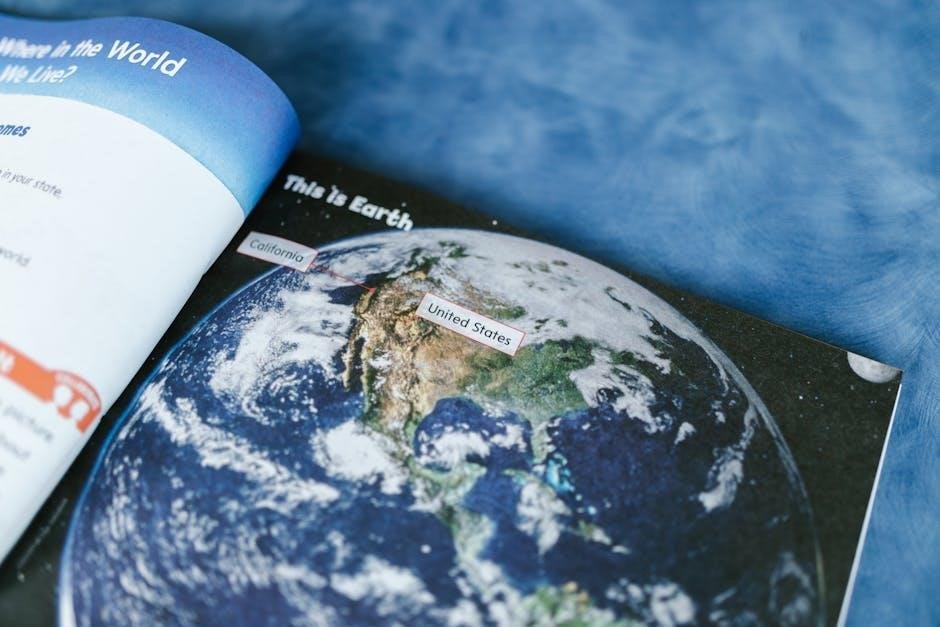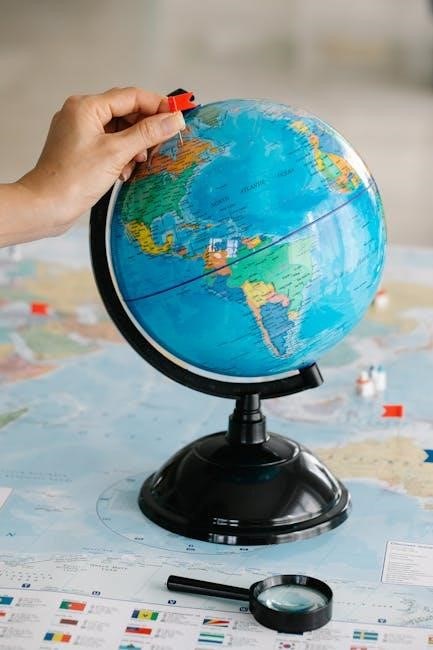Key Themes and Concepts of Unit 4
Unit 4 explores transoceanic interconnections, maritime empires, and globalization from 1450-1750. It examines technological diffusion, the Columbian Exchange, cross-cultural interactions, and economic systems like chattel slavery.
1.1. Transoceanic Interconnections (1450-1750)
Transoceanic interconnections during 1450-1750 were driven by maritime exploration and the establishment of global trade networks. European powers, such as the Portuguese and Spanish, dominated shipping routes, connecting Europe, Africa, Asia, and the Americas. The diffusion of technologies like the carrack and advanced navigation tools facilitated these connections. This period saw the Columbian Exchange, where plants, animals, and diseases were transferred between the Old and New Worlds, profoundly impacting societies; Cross-cultural interactions and trade flourished, with goods like spices, textiles, and precious metals being exchanged. These interconnections reshaped economies, cultures, and societies, laying the foundation for globalization and its far-reaching consequences.

1.2. Maritime Empires and Their Impact
Maritime empires, established by European powers like Portugal and Spain, dominated global trade and politics from 1450 to 1750. These empires relied on control of strategic shipping routes, colonies, and naval superiority. Economic motivations, such as the pursuit of wealth, resources, and new markets, drove their expansion. The Portuguese and Spanish empires, in particular, established vast networks spanning the Atlantic, Indian Ocean, and beyond. Their dominance facilitated the transfer of goods, ideas, and cultures but also led to exploitation, cultural disruption, and conflict in colonized regions. The rise and maintenance of these empires fundamentally reshaped global power dynamics and laid the groundwork for modern globalization.

1.3. Globalization and Its Effects
Globalization during 1450-1750 transformed the world through increased interconnectedness, driven by maritime empires and trade networks. It facilitated the exchange of goods, cultures, and ideas across vast regions, fostering economic growth and cultural diversity. However, it also led to exploitation, as European powers extracted resources and labor from colonized areas. The Columbian Exchange exemplifies this, transferring plants, animals, and diseases between hemispheres, with profound societal impacts. Globalization reshaped power dynamics, creating wealth for some while perpetuating inequality and displacement for others. Its effects were complex, laying the foundation for modern global systems while leaving lasting legacies of both progress and exploitation.

Maritime Empires: Establishment and Maintenance
Maritime empires were established through control of shipping routes, economic backing, and military power. European powers like Portugal and Spain dominated trade, shaping global connections and wealth distribution.

2.1. Portuguese and Spanish Control Over Shipping Routes
Portugal and Spain dominated global shipping routes from 1450-1750, securing key trade paths in the Atlantic, Indian Ocean, and beyond. Portugal’s financing of explorers like Vasco da Gama opened Asian markets, while Spain’s voyages, led by Columbus, established American trade networks. Their control over these routes enabled the transfer of goods, ideas, and cultures, solidifying their economic and political power. This dominance facilitated the exchange of spices, textiles, and precious metals, shaping global commerce and cultural interactions. Their maritime supremacy laid the foundation for modern globalization, connecting Europe, Asia, Africa, and the Americas in unprecedented ways.
2.2. Economic Motivations Behind Maritime Exploration
Maritime exploration during 1450-1750 was driven by economic motives, primarily the pursuit of wealth and resources. European nations sought new trade routes to access spices, gold, and other valuable commodities. The desire to bypass expensive overland routes and establish direct sea trade with Asia fueled expeditions. Additionally, the quest for new markets and colonies aimed to enhance national wealth and power. Economic competition among European powers further accelerated exploration, as nations like Portugal and Spain invested heavily in naval technology and voyages to secure lucrative monopolies. This economic rivalry shaped global trade patterns and laid the groundwork for colonial empires.
Technological Diffusion During 1450-1750
Technological advancements like the carrack and fluyt revolutionized navigation and trade, while tools such as the astrolabe and compass facilitated maritime exploration and cultural exchange.
3.1. The Carrack and Its Role in Navigation
The carrack, a three- or four-masted sailing ship, played a pivotal role in navigation during the 1450-1750 period. Originating in Europe, it combined Mediterranean and Atlantic maritime technologies, featuring a sternpost rudder, lateen sails, and a square-rigged foremast. This design enhanced maneuverability, speed, and cargo capacity, making it ideal for transoceanic voyages. The carrack facilitated European exploration and trade, enabling the establishment of maritime empires. Its diffusion from Spain and Portugal across Europe accelerated global connectivity. The carrack’s adaptability allowed it to dominate both military and commercial shipping, shaping the Age of Exploration and the interconnectedness of the early modern world.
3.2. The Fluyt and Its Impact on Trade
The fluyt, a Dutch merchant ship, emerged in the 17th century and revolutionized trade by prioritizing cargo capacity over armament. Its streamlined design and shallow draft enabled efficient navigation of coastal waters and rivers, making it ideal for bulk goods like grain, timber, and textiles. The fluyt’s cost-effectiveness and versatility facilitated the growth of the Dutch maritime economy, establishing the Netherlands as a dominant trading power. Its widespread adoption across Europe accelerated commercial exchanges, contributing to the expansion of global trade networks during the early modern period. The fluyt’s influence extended beyond economics, shaping the technological evolution of maritime trade vessels.
3.3. Navigation Tools and Their Evolution
Navigation tools evolved significantly between 1450 and 1750, enabling more precise and efficient maritime exploration. The astrolabe, a key instrument for celestial navigation, became widely used, while the sextant later improved angle measurements. The magnetic compass remained essential for direction, and the development of the chronometer in the 18th century revolutionized longitude calculation. These advancements, along with improved cartography and the use of triangulation, facilitated safer and more accurate long-distance voyages. Such technological progress was critical in expanding global trade networks and fostering intercontinental connections during this period of maritime expansion and globalization.

The Columbian Exchange
The Columbian Exchange transferred plants, animals, and diseases between the Americas and Afro-Eurasia, profoundly altering societies, economies, and cultures on both sides of the Atlantic.
4.1. Impact on Societies of the Western Hemisphere
The Columbian Exchange had a profound impact on societies in the Western Hemisphere. The introduction of European crops like wheat and barley transformed agriculture, while the arrival of horses revolutionized transportation and warfare. However, the exchange also brought devastating consequences, including the spread of diseases such as smallpox and measles, to which indigenous populations had no immunity. This led to significant population decline, social disruption, and economic collapse in many Native American communities. Additionally, the introduction of enslaved Africans through the transatlantic slave trade further altered the demographic and cultural landscape of the Americas. These changes reshaped societies forever.
4.2. Exchange of Plants, Animals, and Diseases

The Columbian Exchange facilitated the transfer of plants, animals, and diseases between the Americas and Afro-Eurasia. Crops like maize, potatoes, and chili peppers were introduced to Europe, Africa, and Asia, enhancing food production and population growth. In return, Europeans brought wheat, sugarcane, and livestock such as horses and pigs to the Americas. However, the exchange also spread diseases, with Europeans introducing smallpox, measles, and influenza to the Americas, decimating indigenous populations; Conversely, syphilis spread to Europe from the Americas. This biological exchange profoundly altered ecosystems, economies, and societies on both sides of the Atlantic, shaping the modern world.
Cross-Cultural Interactions and Trade
Cross-cultural interactions and trade were central to global connections, driving the exchange of goods, ideas, and technologies that transformed societies and economies from 1450 to 1750.
5.1. Changes in Patterns of Trade and Travel
The period from 1450 to 1750 saw significant changes in trade and travel patterns due to maritime exploration and the establishment of new shipping routes. European powers, particularly Portugal and Spain, dominated global trade networks, connecting the Atlantic, Indian Ocean, and Pacific regions. The introduction of new ship designs, such as the carrack and fluyt, facilitated more efficient and profitable trade. These advancements enabled the exchange of goods, ideas, and cultures across vast distances. The expansion of trade routes also led to the growth of global economic systems, fostering interdependence among regions and reshaping the flow of resources and knowledge worldwide.
5.2. Cultural and Technological Exchanges
Cultural and technological exchanges flourished during the 1450-1750 period, driven by cross-cultural interactions and maritime connections. The diffusion of technologies like the carrack from Europe and the fluyt from the Netherlands revolutionized navigation and trade. Cultural exchanges included the transfer of plants, animals, and diseases through the Columbian Exchange, profoundly impacting societies in the Western Hemisphere. Additionally, the spread of ideas, religions, and art forms enriched the cultural diversity of connected regions. These exchanges not only facilitated economic growth but also fostered mutual understanding and innovation, shaping the globalized world of the early modern era.

Economic and Labor Systems

Unit 6 covers economic systems, focusing on chattel slavery’s development and its social, economic implications, alongside the rise of wage labor during early globalization.
6.1. Chattel Slavery and Its Development
Chattel slavery emerged as a dominant labor system during 1450-1750, particularly in the Americas. It was characterized by the enslavement of people, often based on race, treating them as property. European powers established triangular trade networks, exchanging enslaved Africans for raw materials and goods. The transatlantic slave trade intensified, with millions forcibly transported to work on plantations. This system perpetuated racial hierarchies and economic exploitation, shaping global economies and societies. Chattel slavery became integral to the production of commodities like sugar, tobacco, and cotton, fueling wealth in Europe and the Americas while devastating African communities and indigenous populations.
6.2. Social and Economic Implications of Slavery
The social and economic implications of slavery were profound and far-reaching. Economically, it fueled the growth of global trade systems, enriching European powers and plantation owners while impoverishing enslaved communities. Socially, it entrenched racial hierarchies, justifying oppression and dehumanization. Slavery disrupted African societies, reducing populations and destabilizing political structures. In the Americas, it led to the displacement and marginalization of indigenous peoples, reshaping demographic landscapes. The legacy of slavery perpetuated inequality, influencing social structures and economic disparities long after its abolition. Its impact remains evident in modern racial and economic inequalities, highlighting the enduring consequences of this exploitative system.